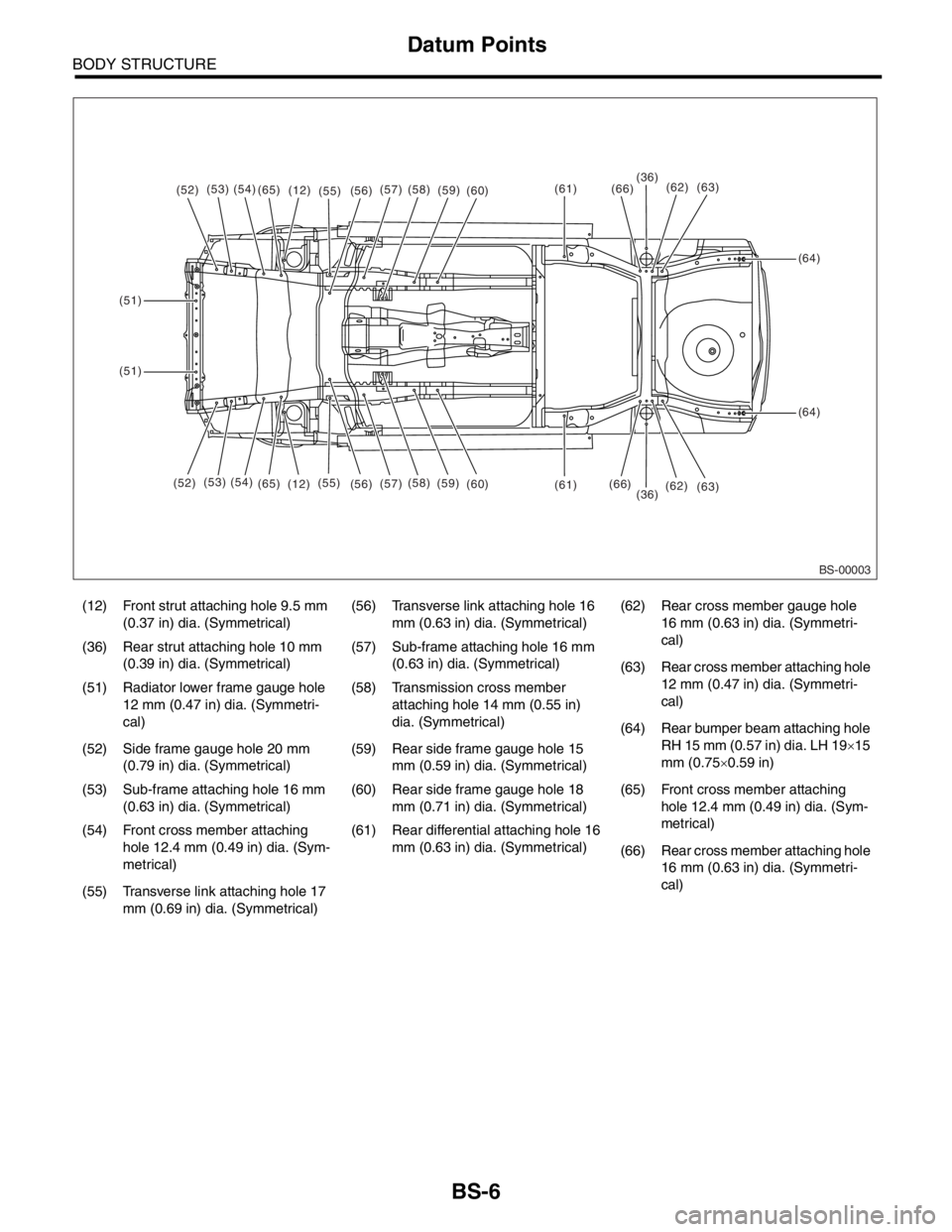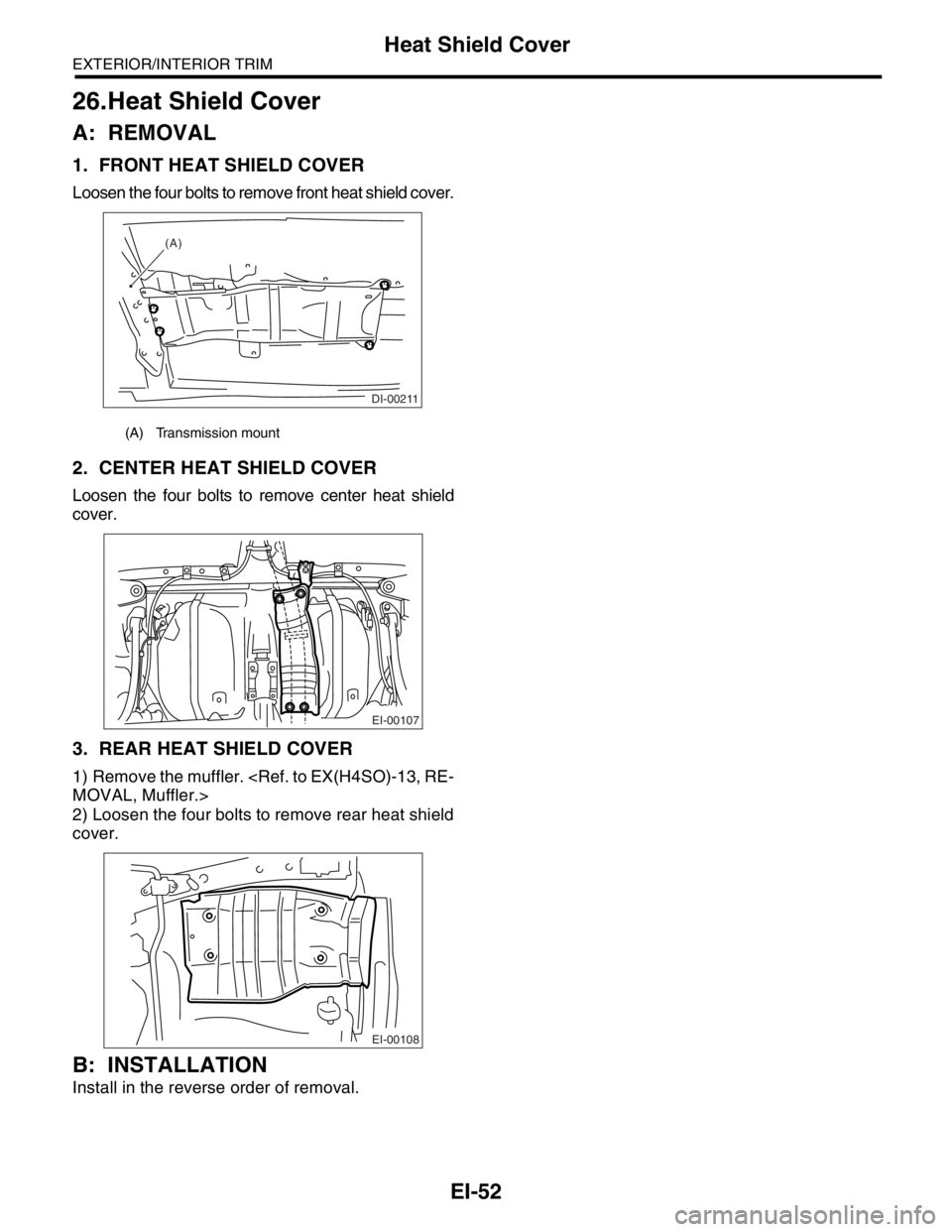2004 SUBARU FORESTER transmission
[x] Cancel search: transmissionPage 372 of 2870

BS-6
BODY STRUCTURE
Datum Points
(12) Front strut attaching hole 9.5 mm
(0.37 in) dia. (Symmetrical)(56) Transverse link attaching hole 16
mm (0.63 in) dia. (Symmetrical)(62) Rear cross member gauge hole
16 mm (0.63 in) dia. (Symmetri-
cal)
(36) Rear strut attaching hole 10 mm
(0.39 in) dia. (Symmetrical)(57) Sub-frame attaching hole 16 mm
(0.63 in) dia. (Symmetrical)
(63) Rear cross member attaching hole
12 mm (0.47 in) dia. (Symmetri-
cal) (51) Radiator lower frame gauge hole
12 mm (0.47 in) dia. (Symmetri-
cal)(58) Transmission cross member
attaching hole 14 mm (0.55 in)
dia. (Symmetrical)
(64) Rear bumper beam attaching hole
RH 15 mm (0.57 in) dia. LH 19×15
mm (0.75×0.59 in) (52) Side frame gauge hole 20 mm
(0.79 in) dia. (Symmetrical)(59) Rear side frame gauge hole 15
mm (0.59 in) dia. (Symmetrical)
(53) Sub-frame attaching hole 16 mm
(0.63 in) dia. (Symmetrical)(60) Rear side frame gauge hole 18
mm (0.71 in) dia. (Symmetrical)(65) Front cross member attaching
hole 12.4 mm (0.49 in) dia. (Sym-
metrical)
(54) Front cross member attaching
hole 12.4 mm (0.49 in) dia. (Sym-
metrical)(61) Rear differential attaching hole 16
mm (0.63 in) dia. (Symmetrical)
(66) Rear cross member attaching hole
16 mm (0.63 in) dia. (Symmetri-
cal)
(55) Transverse link attaching hole 17
mm (0.69 in) dia. (Symmetrical)
BS-00003
(52)(53)(54)(65)(12)(55)(61)
(61)
(64)
(64)
(51)
(51)
(36)
(36)(66)
(66)(56)(57)(58)(59)(60)
(52)(53) (54)
(65)
(12)(55)
(56)(57)(58)
(59)
(60)(62)
(62)(63)
(63)
Page 390 of 2870

IDI-6
INSTRUMENTATION/DRIVER INFO
Combination Meter System
4. CHECK TRANSMISSION CONTROL MODULE (TCM)
3 CHECK HARNESS BETWEEN VEHICLE
SPEED SENSOR AND ENGINE GROUND.
1) Turn the ignition switch to OFF.
2) Measure the resistance between vehicle
speed sensor connector and engine ground.
Connector & terminal
(B17) No. 2 — Engine ground:Is the resistance less than 10
Ω?Go to step 4.Repair the wiring
harness.
4 CHECK HARNESS BETWEEN VEHICLE
SPEED SENSOR AND COMBINATION
METER.
1) Disconnect the connector from combination
meter.
2) Measure the resistance between vehicle
speed sensor harness connector and combi-
nation meter harness connector.
Connector & terminal
(B17) No. 1 — (i10) No. 12:Is the resistance less than 10
Ω?Replace the vehi-
cle speed sensor.Repair the wiring
harness.
Step Check Yes No
1 CHECK TCM SIGNAL.
1) Lift-up the vehicle and support it with rigid
racks.
2) Drive the vehicle faster than 10 km/h (6
MPH).
Warning:
Be careful not to get caught in the running
wheels.
3) Measure the voltage between TCM con-
nector and chassis ground.
Connector & terminal
(B56) No. 17 (+) — Chassis ground (
−):Is the voltage 1 V ← → 5 V? Go to step 2.Check TCM.
Basic Diagnostic
Procedure.>
2 CHECK HARNESS BETWEEN TCM AND
COMBINATION METER.
1) Turn the ignition switch to OFF.
2) Disconnect the connector from TCM and
combination meter.
3) Measure the resistance between TCM har-
ness connector and combination meter har-
ness connector.
Connector & terminal
(B56) No. 17 — (i10) No. 12:Is the resistance less than 10
Ω?Check the speedo
meter.
Speedometer.>Repair the wiring
harness. Step Check Yes No
Page 436 of 2870

SL-16
SECURITY AND LOCK
Keyless Entry System
2. CHECK TRANSMITTER BATTERY
3. CHECK FUSE
The room light and ignition switch illu-
mination operation does not activate.1. Check the room light operation.
Keyless Entry System.>
2. Check the ignition switch illumination circuit.
INSPECTION, Keyless Entry Sys-
tem.>
3. Replace the keyless entry control module.
(without double lock)
4. Replace the double lock module. (with double
lock)
Step Check Yes No
1 CHECK TRANSMITTER BATTERY.
1) Remove the battery from transmitter.
2) Check the battery voltage.
NOTE:
If the transmitter battery voltage is 2.5 V or less,
the range of transmission becomes very short.Is the voltage more than 2.5 V? If further inspec-
tion is necessary,
refer to “SYMP-
TOM CHART”.
CHART, INSPEC-
TION, Keyless
Entry System.>Replace the trans-
mitter battery.
Step Check Yes No
1 CHECK FUSE.
Remove and visually check the fuse No. 2 (in
the main fuse box), No. 3 (in the fuse and relay
box) and SBF-6 (in the main fuse box)Is the fuse blown out? Replace the fuse
with a new one.Check the power
supply and ground
circuit.
POWER SUPPLY
AND GROUND
CIRCUIT,
INSPECTION,
Keyless Entry Sys-
tem.> Symptom Repair order Reference
Page 528 of 2870

EI-52
EXTERIOR/INTERIOR TRIM
Heat Shield Cover
26.Heat Shield Cover
A: REMOVAL
1. FRONT HEAT SHIELD COVER
Loosen the four bolts to remove front heat shield cover.
2. CENTER HEAT SHIELD COVER
Loosen the four bolts to remove center heat shield
cover.
3. REAR HEAT SHIELD COVER
1) Remove the muffler.
2) Loosen the four bolts to remove rear heat shield
cover.
B: INSTALLATION
Install in the reverse order of removal.
(A) Transmission mount
DI-00211
(A)
EI-00107
EI-00108
Page 599 of 2870

CC(H4SO)-31
CRUISE CONTROL SYSTEM (DIAGNOSTIC)
Diagnostic Procedure with Diagnostic Trouble Code (DTC)
Step Check Yes No
1 CHECK TRANSMISSION TYPE.Is the target MT model? Go to step 2.Go to step 6.
2 CHECK HARNESS BETWEEN BATTERY
AND VEHICLE SPEED SENSOR.
1) Turn the ignition switch to OFF.
2) Disconnect the harness connector from
vehicle speed sensor.
3) Turn the ignition switch to ON.
4) Measure the voltage between vehicle
speed sensor harness connector terminal and
chassis ground.
Connector & terminal
(B17) No. 3 (+) — Chassis ground (
−):Is the voltage more than 10 V? Go to step 3.Check the harness
for open or short
between fuse relay
and vehicle speed
sensor.
3 CHECK HARNESS BETWEEN CRUISE CON-
TROL MODULE AND VEHICLE SPEED SEN-
SOR.
1) Turn the ignition switch to OFF.
2) Disconnect the harness connector from
cruise control module.
3) Measure the resistance between vehicle
speed sensor harness connector terminal and
cruise control module harness connector ter-
minal.
Connector & terminal
(B17) No. 1 — (B94) No. 19:Is the resistance less than 10
Ω?Go to step 4.Repair the har-
ness.
4 CHECK HARNESS BETWEEN VEHICLE
SPEED SENSOR AND ENGINE GROUND.
1) Turn the ignition switch to OFF.
2) Measure the resistance between vehicle
speed sensor harness connector terminal and
engine ground.
Connector & terminal
(B17) No. 2 — Engine ground:Is the resistance less than 10
Ω?Go to step 5.Repair the har-
ness.
5 CHECK VEHICLE SPEED SENSOR.
1) Connect the harness connector to vehicle
speed sensor.
2) Lift-up the vehicle and support with rigid
racks.
3) Drive the vehicle at speed greater than 20
km/h (12 MPH).
Warning:
Be careful not to be caught up by the run-
ning wheels.
4) Measure the voltage between cruise control
module harness connector terminal and chas-
sis ground.
Connector & terminal
(B94) No. 19 (+) — Chassis ground (
−):Is the voltage less than 0 V ←
→ more than 5 V?Replace the cruise
control module.
Module.>Replace the vehi-
cle speed sensor.
6 CHECK HARNESS BETWEEN CRUISE CON-
TROL MODULE AND TCM.
1) Turn the ignition switch to OFF.
2) Disconnect the harness connector from
TCM and cruise control module.
3) Measure the resistance between cruise
control module harness connector terminal
and TCM harness connector terminal.
Connector & terminal
(B94) No. 19 — (B56) No. 17:Is the resistance less than 10
Ω?Go to step 7.Repair the har-
ness.
Page 600 of 2870

CC(H4SO)-32
CRUISE CONTROL SYSTEM (DIAGNOSTIC)
Diagnostic Procedure with Diagnostic Trouble Code (DTC)
7 CHECK TCM.
1) Connect the harness connector to TCM.
2) Lift-up the vehicle and support with rigid
racks.
3) Drive the vehicle faster than 10 km/h (6
MPH).
Warning:
Be careful not to be caught by the running
wheels.
4) Measure the voltage between TCM har-
ness connector terminal and chassis ground.
Connector & terminal
(B56) No. 17 (+) — Chassis ground (
−):Is the voltage less than 0 V ←
→ more than 5 V?Replace the cruise
control module.
Module.>Replace the TCM.
trol Module
(TCM).> Step Check Yes No
Page 635 of 2870

CC(H4DOTC 2.5)-23
CRUISE CONTROL SYSTEM (DIAGNOSTIC)
Diagnostic Procedure with Diagnostic Trouble Code (DTC)
Step Check Yes No
1 CHECK TRANSMISSION TYPE.Is the target MT model? Go to step 2.Go to step 5.
2 CHECK NEUTRAL POSITION SWITCH CIR-
CUIT.
1) Turn the ignition switch to OFF.
2) Disconnect the neutral position switch har-
ness connector.
3) Turn the ignition switch to ON.
4) Measure the voltage between harness con-
nector terminal and chassis ground.
Connector & terminal
(B128) No. 1 (+) — Chassis ground (
−): Is the voltage more than 10 V? Go to step 3.Check the harness
for open or short
between neutral
position switch and
ECM.
3 CHECK NEUTRAL POSITION SWITCH CIR-
CUIT.
1) Turn the ignition switch to OFF.
2) Measure the resistance between neutral
position switch harness connector terminal and
chassis ground.
Connector & terminal
(B128) No. 3 — Chassis ground: Is the resistance less than 10
Ω? Go to step 4.Repair the har-
ness.
4 CHECK NEUTRAL POSITION SWITCH.
Remove and check the neutral position switch. Is the neutral position switch
OK? Neutral position
switch circuit is
OK.Replace the neu-
tral position switch.
5 CHECK INHIBITOR SWITCH CIRCUIT.
1) Turn the ignition switch to OFF.
2) Disconnect the inhibitor switch harness
connector.
3) Turn the ignition switch to ON.
4) Measure the voltage between harness con-
nector terminal and chassis ground.
Connector & terminal
(T7) No. 12 (+) — Chassis ground (
−): Is the voltage more than 10 V? Go to step 6.Check the harness
for open or short
between inhibitor
switch and ECM.
6 CHECK INHIBITOR SWITCH CIRCUIT.
1) Turn the ignition switch to OFF.
2) Measure the resistance between inhibitor
switch harness connector terminal and chassis
ground.
Connector & terminal
(T7) No. 7 — Chassis ground: Is the resistance less than 10
Ω? Go to step 7.Repair the har-
ness.
7 CHECK INHIBITOR SWITCH.
Remove and check the inhibitor switch. Is the inhibitor switch OK? Inhibitor switch cir-
cuit is OK.Replace the inhibi-
tor switch.
Page 639 of 2870

CC(H4DOTC 2.5)-27
CRUISE CONTROL SYSTEM (DIAGNOSTIC)
Diagnostic Procedure with Diagnostic Trouble Code (DTC)
Step Check Yes No
1 CHECK TRANSMISSION TYPE.Is the target MT model? Go to step 2.Go to step 6.
2 CHECK HARNESS BETWEEN BATTERY
AND VEHICLE SPEED SENSOR.
1) Turn the ignition switch to OFF.
2) Disconnect the harness connector from
vehicle speed sensor.
3) Turn the ignition switch to ON.
4) Measure the voltage between vehicle
speed sensor harness connector terminal and
chassis ground.
Connector & terminal
(B17) No. 3 (+) — Chassis ground (
−):Is the voltage more than 10 V? Go to step 3.Check the harness
for open or short
between fuse and
vehicle speed sen-
sor.
3 CHECK HARNESS BETWEEN ECM AND VE-
HICLE SPEED SENSOR.
1) Turn the ignition switch to OFF.
2) Disconnect the harness connector from
ECM.
3) Measure the resistance between vehicle
speed sensor harness connector terminal and
ECM harness connector terminal.
Connector & terminal
(B17) No. 1 — (B135) No. 26:Is the resistance less than 10
Ω?Go to step 4.Repair the har-
ness.
4 CHECK HARNESS BETWEEN VEHICLE
SPEED SENSOR AND ENGINE GROUND.
1) Turn the ignition switch to OFF.
2) Measure the resistance between vehicle
speed sensor harness connector terminal and
engine ground.
Connector & terminal
(B17) No. 2 — Engine ground:Is the resistance less than 10
Ω?Go to step 5.Repair the har-
ness.
5 CHECK VEHICLE SPEED SENSOR.
1) Connect the harness connector to vehicle
speed sensor.
2) Lift-up the vehicle and support with rigid
racks.
3) Drive the vehicle at speed greater than 20
km/h (12 MPH).
Warning:
Be careful not to be caught up by the run-
ning wheels.
4) Measure the voltage between ECM har-
ness connector terminal and chassis ground.
Connector & terminal
(B135) No. 26 (+) — Chassis ground (
−):Is the voltage 1 V ← → 5 V? Check the poor
contact of ECM
connector.Replace the vehi-
cle speed sensor.
6 CHECK HARNESS BETWEEN ECM AND
TCM.
1) Turn the ignition switch to OFF.
2) Disconnect the harness connector from
ECM and TCM.
3) Measure the resistance between ECM har-
ness connector terminal and TCM harness
connector terminal.
Connector & terminal
(B135) No. 26 — (B56) No. 1:Is the resistance less than 10
Ω?Go to step 7.Repair the har-
ness.